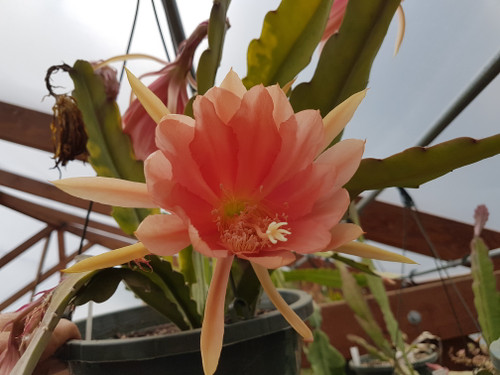Pot Size: 3.5"
Accepted Scientific Name: Epiphyllum 'Pierette'
Origin and Habitat:
Epiphyllum hybrids trace their lineage to epiphytic cacti native to Central and South America, where they naturally grow in warm, humid tropical forests. These plants thrive by attaching themselves to trees or rocky outcroppings, absorbing nutrients from decaying plant material and consistent moisture from rainfall and humidity. Hybrid cultivars such as Epiphyllum 'Pierette' were selectively bred for ornamental use, carrying forward the striking floral traits and adaptability of their wild ancestors. Their cultivation outside natural habitats has made them cherished greenhouse and indoor plants worldwide, especially valued for their large, vividly colored flowers.
Description:
Epiphyllum 'Pierette' forms long, flat, arching stems that typically reach 18–24 inches in length, creating a cascading growth habit. Its flowers are breathtaking, averaging 7–9 inches across, with wide, layered petals in vibrant shades of pink and rose, blending into softer inner tones near the throat. The large blossoms open in spectacular fashion, producing a showy and elegant display that captures attention during its blooming period. The floral presentation makes it especially prized among collectors and enthusiasts.
Cultivation:
Zone: Best suited for Zones 10–11; can be grown indoors or in greenhouses in cooler regions.
Temperature: Ideal range is 15–27°C; protect from temperatures below 5°C.
Growth rate: Moderate, with faster growth in warm, humid environments.
Soil: Use a well-draining organic substrate with pumice to maintain aeration and prevent root rot.
Watering: Keep soil evenly moist during active growth and flowering; reduce watering in cooler dormant months.
Fertilizing: Feed with a diluted balanced fertilizer every 2–3 weeks in spring and summer.
Light: Bright, indirect light is preferred; avoid prolonged direct sun that may burn stems.
Pests and diseases: May occasionally be affected by mealybugs, scale, aphids, or fungal issues if overwatered.
Propagation:
Easily propagated from stem cuttings, which should be callused before planting in a pumice-enriched medium.







